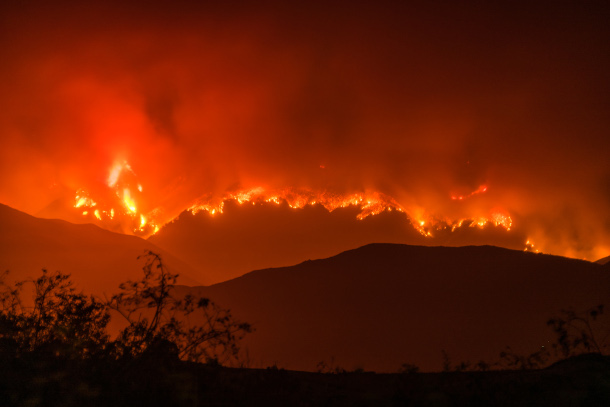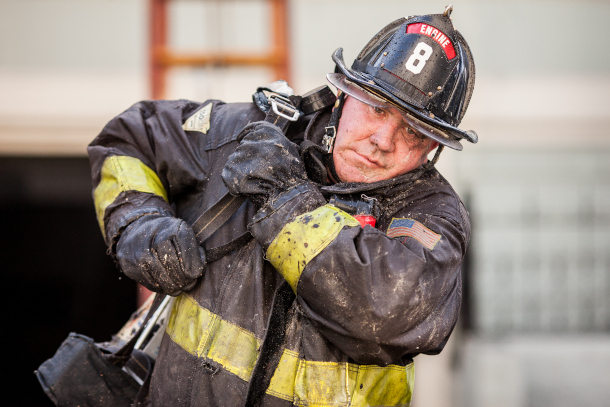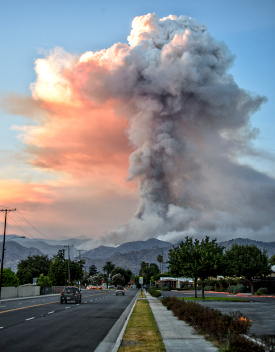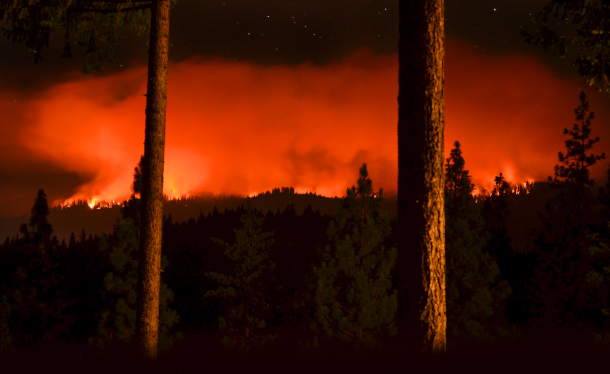Mastering Fire with Fire
Air Date: Week of September 11, 2020

A wildfire in Goleta, California. (Photo: Glen Beltz, Flickr, CC By 2.0)
In California, Oregon and Washington, the 2020 fire season is one for the record books, with millions of acres burned and many thousands of people displaced. Fires are inevitable in much of the West due to the region’s ecology, but devasting megafires aren’t, according to Timothy Ingalsbee, founding director of Firefighters United for Safety, Ethics, and Ecology (FUSEE). He joins Living on Earth’s Jenni Doering to discuss how fire management can keep megafires from erupting and keep communities safe.
Transcript
BASCOMB: From PRX and the Jennifer and Ted Stanley Studios at the University of Massachusetts Boston, this is Living on Earth, I’m Bobby Bascomb.
DOERING: And I’m Jenni Doering. For California, Oregon, and Washington, the 2020 wildfire season is one for the record books. With the flames and destruction captured on the CBS Evening News.
REPORTER: The wildfires burning throughout the West are especially destructive this year. Scientists say they’re fueled by climate change, the fires now ripping through several states, leaving a path of immeasurable destruction.
DOERING: With months still to go in this year’s fire season, California alone has already seen more acres burn than any other year on record -- more than 2.6 million acres so far. But this fiery destruction isn’t inevitable. In fact, experts like Timothy Ingalsbee say more fire, not less, is what’s needed to help tame these megafires. He’s the founding director of Firefighters United for Safety, Ethics, and Ecology. Welcome to Living on Earth!
INGALSBEE: Thank you. Great to be here.
DOERING: So this year, we've seen the biggest wildfire season in California history. Why are we seeing such big fires that burned so many acres? And how did we get to this point?
INGALSBEE: Well, there's a variety of reasons but the primary driver is climate change, prolonged droughts and record heat waves, combined with freakish lightning storms, that are creating these giant fire complexes that's multiple ignitions simultaneously. And then, you know, people living all over the landscape, particularly in very fire prone environments. And then, you know, combined with a past century or more of excluding fire from the land and fighting all fires, we've just got all the prime ingredients for these kinds of, you know, fire storm activities.
DOERING: So what is really going on with climate change and wildfires? Why does it make wildfires so much more common and large when they happen in California?

A member of the San Francisco Fire Department. (Photo: Thomas Hawk, Flickr CC BY-NC 2.0)
INGALSBEE: Well, in terms of just accumulating the amount of air you're burned wildfire seasons are lengthening, because you know, the winter snows and rains are coming later, and that snow was melting earlier. And it's just in the last 20-30 years, it's extended the fire season over two months. And that has a toll on wildland firefighters. They are just beat up by mid summer. And in California in particular, it's almost the end of this notion of a fire season. Year round, various places could be, you know, prone to ignition and, you know, fire spreading. So it's lengthy in the fire season. And then the rising temperatures makes everything on the ground easier to ignite. And once ignited, faster spread. And that's the real issue. What's happening today why the fires are so big, they're moving so fast, way faster than firefighters can kind of get out ahead, some cases faster than people can flee.
DOERING: So you say that there's a solution. We don't have to live like this with these fires completely getting out of control. What would you recommend?
INGALSBEE: The best thing that affects fire is fire itself. Those fires that are burning, you know, in spring and late, late summer fall under moderate conditions are doing very vital work for the ecosystem and keeping it stable, sustainable. This summer is clear. If some of those fires last summer, we hadn't been so aggressively attacking and putting out those would have provided buffers this year for the fires that are burning under these extreme weather conditions. Last year, they're moderate weather conditions and they would have done really good things. This year, that same areas that we put out here are now burning, you know, out of our control.
DOERING: Right? I mean, so correct me if I'm wrong, but I thought that you know, when a fire is sparked in a wilderness area, for whatever reason, I was under the impression that fire managers kind of watch it. If it's going to threaten structures, then they'll move in. But right now, in terms of fire policy, are we letting any of these, you know, fires that aren't necessarily threatening structures, are we letting them burn or are we just sort of stamping them out as soon as they start?
INGALSBEE: Well, the beginning of the season with the best of intentions relate to the Coronavirus crisis, the forest service said we're going to fight off fires aggressively upon detection. This is going back to the fire policies of the 1930s, what they called the 10 a.m. policy. So, you know, in June in July, they were sending hundreds of crews, even to remote wilderness areas like the Trinity Alps wilderness area, the Ventana wilderness area, fighting fires, they're trying to put them out and stop the smoke. Well, lo and behold, we had this huge lightning storm, fires everywhere down in the Central Valley and you know, Santa Cruz, I mean and hundreds of crews were stuck in the wilderness trying to do, you know, places shouldn't have been, doing things they shouldn't be doing when they were sorely needed elsewhere. And so we got caught there.

A tower of smoke visible from the road in Azusa, California. (Photo: Russ Allison Loar, Flickr, CC BY-NC-ND 2.0)
DOERING: So it sounds like you're saying this is a recent change this year that we're harkening back now to policies from the 1930s, where we're gonna fight all fires. So for a while, for several decades, we weren't necessarily putting out all the fires, is that correct?
INGALSBEE: Well, we've made that policy. The Forest Service and National Parks were made that policy in the 60s and late 70s, from fire control, you know, fight all fires to fire management. But that policy was made on paper, not necessarily in practice, in actual practice, the Forest Service, for example, still aggressively attacks, you know, 90 to 95% of all wildfires. It's just the bare minimum that they actually, you know, manage and these are some of the most remote wilderness areas. Well this year, they kind of went backwards on even that small amount of fires that they would manage. So yeah, it's been attack all fires. And it's a slippery slope. They said it's just just this year, just while we have the Coronavirus crisis, try to eliminate smoke, but we're going to have the virus with us next year. We're certainly going to have climate change with us next year, we're going to have probably even more wildfire activity. This is the reality now while there's increasing wildfire activity, and it's you know, we done and tried our best to change nature to our liking. It's time that we start getting a grip on our own behavior and the way we live our lives, you know, with these flammable buildings, fueled by all this fossil fuel burning, and that's what something that we can control. We can solve for those those issues and those problems. Once we do that, once we protect communities from fire, then we can start, you know, talking about how to manage and restore ecosystems with fire.
DOERING: You know, you're talking about these things that we know we can do building more resilient communities and harnessing fire. Why isn't the policy caught up?
INGALSBEE: Well, it's more than policy. There's there's other drivers like culture, for example. I mean, people have been socially conditioned to fear fire. And this is really a complete anomaly to what our species is, you know, part of our species' success was our ability and our knowledge to use fire. We're the only species that knows how to start fire. And probably the only one crazy enough to try to stop all fires, especially that have, you know, been been part of the Earth for 400 million years. And part of just about every indigenous people's ability to survive on this continent for tens of thousands of years. So it's culture but it's also kind of politics and bureaucracy, and the government agencies are all, you know, fired up to wage war on wildfire. And there's very powerful political and economic interests with vested stakes and perpetuating that kind of war like mode. And so in other interests that are trying to opportunistically use wildfires to further other agendas, you know, let's log those trees before they burn. that'll solve the problem. Well, no, it's a spurious connection. And it's actually counterproductive because that's what's burning in California is not so much forest. But was what the shrub lands and grasslands that were grown in the wake of forest that were gone.
DOERING: Right. So it sounds like there's an incentive for, you know, this war like mode that you're saying the just attacking fire whenever we can. But I'm wondering to what extent is there also an economic argument to be made in favor of sustainable preventative fire management using some controlled burning perhaps rather than simply reacting on an emergency basis to mega fires.

A forest fire in Plumas County, California. (Photo: Fueling Creative Fire, Flickr, CC BY-ND 2.0)
INGALSBEE: Well, right now we we spend on the scale of billions of tax dollars every year in emergency fire suppression. If we would just take a portion of that and invest in protecting, you know, preparing homes and communities, let's say replace every rural home in America with a metal roof. That alone would increase that structure's ability to survive wildfire over 90%, and this is a matter of physics, okay. Now that would be very expensive, but that would be a one and done cost. And then that home, that structure, would be safe from, you know, embers igniting its roof. That would be expensive, but one time costs versus billions spent every year on emergency fire suppression, hundreds of millions more and all these fuels reduction projects that must be done every year in perpetuity.
DOERING: Dr. Inglesby before you go, what's something about wildfires that you really wish that others could understand?
INGALSBEE: Majority of fires in wild lands, okay, those are real wildfires. They're not these giant tsunamis of flame that consume everything in its path. They're really spotty. And you know, most of the burned acres come from flames on the ground. And yeah, they may torch up a tree or a cluster of trees here. But they're really diverse in their behavior and effects. And this pyrodiversity plays a major role in biodiversity. So these wildfires in wild places are really how those places evolved and really require that this kind of ecological stimulus, if you will, it's not a natural disturbance. It's an ecological stimulus. But those fires are different from the ones that affect our homes communities. These urban wildfires are truly disasters. They destroy homes and they kill people. So they're really two different fires. And we got all of our focus on those wildfires. And we really need to start focusing on those urban fires.
DOERING: Timothy Inglesby is founding director of FUSEE, firefighters United for Safety, Ethics and Ecology. Thank you so much, Timothy.
INGALSBEE: Thank you. It's a pleasure and everyone keeps safe out there.
Links
ProPublica | “They Know How to Prevent Megafires. Why Won’t Anybody Listen?”
Living on Earth wants to hear from you!
Living on Earth
62 Calef Highway, Suite 212
Lee, NH 03861
Telephone: 617-287-4121
E-mail: comments@loe.org
Newsletter [Click here]
Donate to Living on Earth!
Living on Earth is an independent media program and relies entirely on contributions from listeners and institutions supporting public service. Please donate now to preserve an independent environmental voice.
NewsletterLiving on Earth offers a weekly delivery of the show's rundown to your mailbox. Sign up for our newsletter today!
 Sailors For The Sea: Be the change you want to sea.
Sailors For The Sea: Be the change you want to sea.
 The Grantham Foundation for the Protection of the Environment: Committed to protecting and improving the health of the global environment.
The Grantham Foundation for the Protection of the Environment: Committed to protecting and improving the health of the global environment.
 Contribute to Living on Earth and receive, as our gift to you, an archival print of one of Mark Seth Lender's extraordinary wildlife photographs. Follow the link to see Mark's current collection of photographs.
Contribute to Living on Earth and receive, as our gift to you, an archival print of one of Mark Seth Lender's extraordinary wildlife photographs. Follow the link to see Mark's current collection of photographs.
 Buy a signed copy of Mark Seth Lender's book Smeagull the Seagull & support Living on Earth
Buy a signed copy of Mark Seth Lender's book Smeagull the Seagull & support Living on Earth

